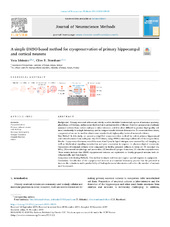A simple DMSO-based method for cryopreservation of primary hippocampal and cortical neurons
Peer reviewed, Journal article
Published version
Permanent lenke
https://hdl.handle.net/1956/22005Utgivelsesdato
2019-03Metadata
Vis full innførselSamlinger
Originalversjon
https://doi.org/10.1016/j.jneumeth.2019.108578Sammendrag
Background Primary neuronal cultures are widely used to elucidate fundamental aspects of neuronal anatomy, physiology, cell biology, and neuronal dysfunction in animal models of disease. However, preparation of primary neuronal cultures from rodent embryos is labor-intensive, and it is often difficult to produce high-quality cultures consistently in a single laboratory, and to compare results between laboratories. To overcome these issues, cryopreservation can be used to obtain more standardized, high-quality banks of neuronal cultures. New Method In this study, we present a simplified cryopreservation method for rodent primary hippocampal and cortical neurons from embryonic day 18.5 fetuses, using DMSO-containing traditional cell freezing medium. Results Cryopreserved neurons stored for more than 1 year in liquid nitrogen were assessed by cell imaging, as well as biochemical signaling transduction and gene expression in response to pharmacological treatments. Cryopreserved neuronal cultures were comparable to freshly prepared cultures in terms of: (1) neuronal viability, (2) neuronal morphology and maturation, (3) functional synapse formation, (4) stimulus responsiveness. These results indicate that DMSO-cryopreserved neurons are equivalent to freshly prepared neurons both developmentally and functionally. Comparison with Existing Methods Our method is simple and does not require special reagents or equipment. Conclusions Introduction of the cryopreserved neurons as a standard laboratory practice has the potential to increase the robustness and reproducibility of findings between laboratories and reduce the number of animals used in research.

